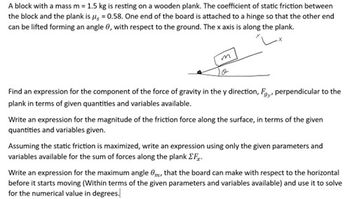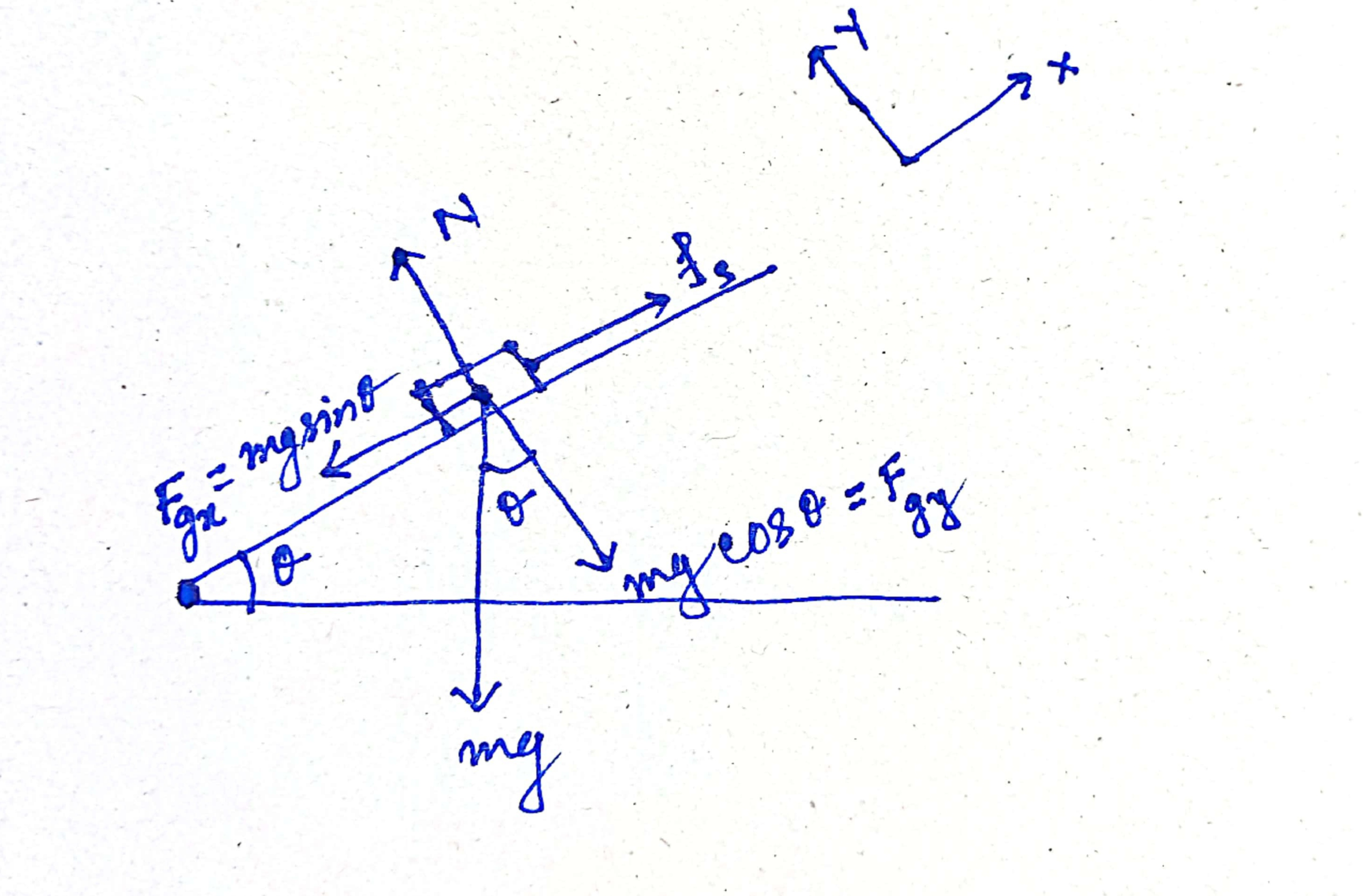
College Physics
11th Edition
ISBN: 9781305952300
Author: Raymond A. Serway, Chris Vuille
Publisher: Cengage Learning
expand_more
expand_more
format_list_bulleted
Concept explainers
Question
thumb_up100%
Need help checking practice problems, image included. Thanks!

Transcribed Image Text:A block with a mass m = 1.5 kg is resting on a wooden plank. The coefficient of static friction between
the block and the plank is μ = 0.58. One end of the board is attached to a hinge so that the other end
can be lifted forming an angle 8, with respect to the ground. The x axis is along the plank.
m
Find an expression for the component of the force of gravity in the y direction, F.,, perpendicular to the
plank in terms of given quantities and variables available.
Write an expression for the magnitude of the friction force along the surface, in terms of the given
quantities and variables given.
Assuming the static friction is maximized, write an expression using only the given parameters and
variables available for the sum of forces along the plank Fx.
Write an expression for the maximum angle Om, that the board can make with respect to the horizontal
before it starts moving (Within terms of the given parameters and variables available) and use it to solve
for the numerical value in degrees.
Expert Solution
arrow_forward
Step 1: Given Information
The gravitational force acting on the object with mass can be resolved into vertical and horizontal components , where the vertical component of weight of the mass ,acts down perpendicular to the x-axis while the normal force, that is (N ) acts up perpendicular to the x-axis. The static frictional force
, opposes the horizontal motion of mass with respect to x-axis. The free body diagram of the system is given below ,

Step by stepSolved in 4 steps with 20 images

Knowledge Booster
Learn more about
Need a deep-dive on the concept behind this application? Look no further. Learn more about this topic, physics and related others by exploring similar questions and additional content below.Similar questions
- to produce an image with a height of +10 cm when the object has a height of +1 cm, the magnification of an optical system must be? a)+10 b)-10 c)0.1 d) -0.1arrow_forwardIdentify the means by which you can use a converging lens to form a virtual image.arrow_forwardAn object placed 15 cm to the left a convex lens produces and image 31 cm on right side of the lens. What is the focal length of this lens? Only numerical answer required. No need for units.arrow_forward
- Question in the attachmentsarrow_forwardA 5.50 cm tall object is 24.0 cm from a concave mirror with f = 20.0 cm. Find the image height. (Mind your minus signs.) (Unit = cm) Academy of Science. All Rights Reserved. Search H Enter 65 huluarrow_forward3. Make an image with a convex lens and a concave lens when object is at C or at 2F. Show your drawing and write four qualities of the images formed.arrow_forward
- Problem 96. Indicate the single lens type (converging or diverging) and object position that will lead to the following kind of images. If no single lens system can produce the particular image indicate that this is so. A) real, upright, enlarged image. B) huge image at "infinity". C) real, enlarged, inverted image. D) tiny inverted image very near the focal point. E) real, reduced in size, inverted image. F) virtual, reduced in size, upright image. G) virtual, enlarged, upright image. H) real, inverted image that is the same size as the object. I) virtual, enlarged, inverted image. Problem 97. You are handed a converging lens and you have a ruler. Describe two different simple ways to determine the focal length of this lens. Each way should involve making only one measurement.arrow_forward(9) Please don't write on a paper. I can't understand handwritten. Kathrine places a 6.95-cm tall candle a distance of 36.5 cm from a concave mirror. What is the height of the image when the focal length of the mirror is 50.0 cm? a. -135.14 cm b. 36.50 cm c. 25.72 cm d. 3.70 cmarrow_forwardDraw image as well please.arrow_forward
arrow_back_ios
SEE MORE QUESTIONS
arrow_forward_ios
Recommended textbooks for you
 College PhysicsPhysicsISBN:9781305952300Author:Raymond A. Serway, Chris VuillePublisher:Cengage Learning
College PhysicsPhysicsISBN:9781305952300Author:Raymond A. Serway, Chris VuillePublisher:Cengage Learning University Physics (14th Edition)PhysicsISBN:9780133969290Author:Hugh D. Young, Roger A. FreedmanPublisher:PEARSON
University Physics (14th Edition)PhysicsISBN:9780133969290Author:Hugh D. Young, Roger A. FreedmanPublisher:PEARSON Introduction To Quantum MechanicsPhysicsISBN:9781107189638Author:Griffiths, David J., Schroeter, Darrell F.Publisher:Cambridge University Press
Introduction To Quantum MechanicsPhysicsISBN:9781107189638Author:Griffiths, David J., Schroeter, Darrell F.Publisher:Cambridge University Press Physics for Scientists and EngineersPhysicsISBN:9781337553278Author:Raymond A. Serway, John W. JewettPublisher:Cengage Learning
Physics for Scientists and EngineersPhysicsISBN:9781337553278Author:Raymond A. Serway, John W. JewettPublisher:Cengage Learning Lecture- Tutorials for Introductory AstronomyPhysicsISBN:9780321820464Author:Edward E. Prather, Tim P. Slater, Jeff P. Adams, Gina BrissendenPublisher:Addison-Wesley
Lecture- Tutorials for Introductory AstronomyPhysicsISBN:9780321820464Author:Edward E. Prather, Tim P. Slater, Jeff P. Adams, Gina BrissendenPublisher:Addison-Wesley College Physics: A Strategic Approach (4th Editio...PhysicsISBN:9780134609034Author:Randall D. Knight (Professor Emeritus), Brian Jones, Stuart FieldPublisher:PEARSON
College Physics: A Strategic Approach (4th Editio...PhysicsISBN:9780134609034Author:Randall D. Knight (Professor Emeritus), Brian Jones, Stuart FieldPublisher:PEARSON

College Physics
Physics
ISBN:9781305952300
Author:Raymond A. Serway, Chris Vuille
Publisher:Cengage Learning

University Physics (14th Edition)
Physics
ISBN:9780133969290
Author:Hugh D. Young, Roger A. Freedman
Publisher:PEARSON

Introduction To Quantum Mechanics
Physics
ISBN:9781107189638
Author:Griffiths, David J., Schroeter, Darrell F.
Publisher:Cambridge University Press

Physics for Scientists and Engineers
Physics
ISBN:9781337553278
Author:Raymond A. Serway, John W. Jewett
Publisher:Cengage Learning

Lecture- Tutorials for Introductory Astronomy
Physics
ISBN:9780321820464
Author:Edward E. Prather, Tim P. Slater, Jeff P. Adams, Gina Brissenden
Publisher:Addison-Wesley

College Physics: A Strategic Approach (4th Editio...
Physics
ISBN:9780134609034
Author:Randall D. Knight (Professor Emeritus), Brian Jones, Stuart Field
Publisher:PEARSON